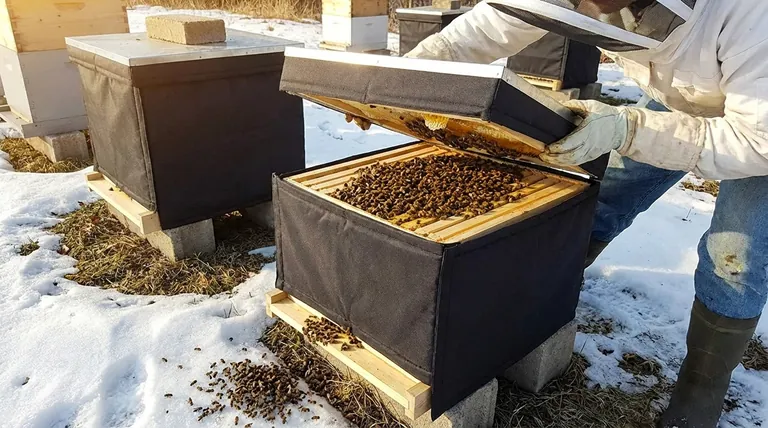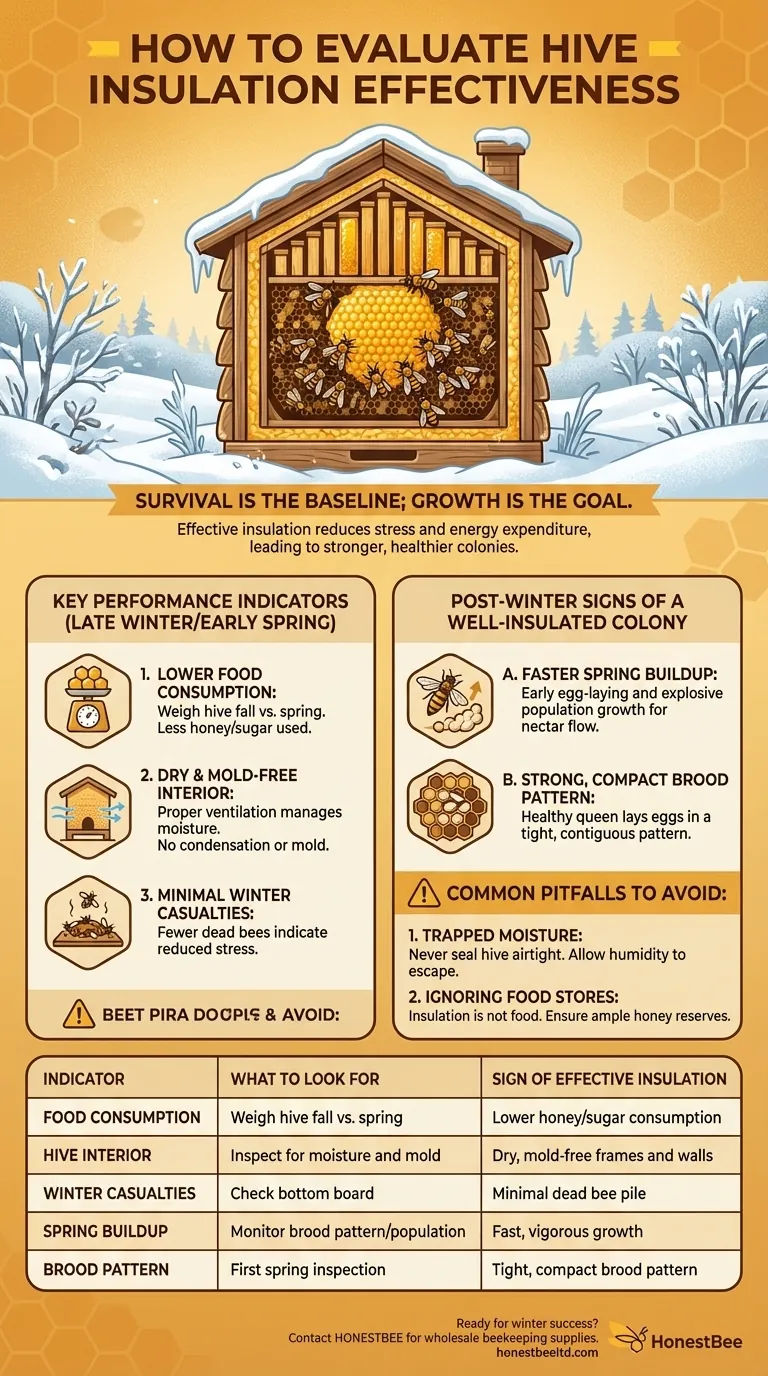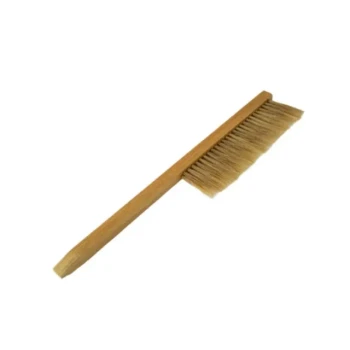The most reliable way to evaluate your hive insulation is by observing the colony's health, resource consumption, and population growth after the winter concludes. Effective insulation doesn't just ensure survival; it enables the colony to emerge from the cold stronger, healthier, and ready for a productive season.
Your goal is not just to help the bees survive winter, but to reduce their stress and energy expenditure. The true measure of effective insulation is a colony that consumes fewer resources and builds up its population faster in the spring.

Key Performance Indicators for Insulation
The effects of good insulation are not a single event but a series of observable outcomes. You can assess its performance by looking at indicators both during the late winter and into the early spring.
Indicator 1: Lower Food Consumption
This is the most direct measure of thermal efficiency. A well-insulated hive retains heat generated by the bee cluster far more effectively.
The bees must burn through their honey stores to generate heat and maintain the cluster's core temperature. Less heat loss directly translates to less energy (honey) being consumed just to stay warm. You can measure this by weighing the hive in the fall and again in the spring.
Indicator 2: A Dry and Mold-Free Interior
A common mistake is to insulate without ensuring proper ventilation. Good insulation practices work in tandem with ventilation to manage moisture.
Warm, moist air from the bees' respiration rises. In a poorly insulated hive, this air hits the cold inner cover, causing condensation to form and drip back down on the cluster, which can be lethal. Proper insulation keeps the interior surfaces warmer, reducing condensation and preventing the growth of mold and mildew.
Indicator 3: Minimal Winter Casualties
While some bee death is normal, a large pile of dead bees on the bottom board or at the entrance is a sign of severe stress.
Effective insulation reduces the strain on the colony, allowing more bees to survive the winter. A smaller number of winter casualties is a clear sign that the cluster was not forced to struggle against extreme cold.
Post-Winter Signs of a Well-Insulated Colony
The true benefits of your efforts become most apparent when the weather warms. A colony that had an easier winter will demonstrate superior vigor and growth.
A Faster Spring Buildup
The most significant advantage of good insulation is a rapid spring population boom. The queen is more likely to begin laying eggs earlier in a warm, stable environment.
Because the colony used less energy for heating, it has more resources and a stronger population to dedicate to raising new brood. This explosive growth allows the colony to be at full strength for the first major nectar flow of the season.
A Strong, Compact Brood Pattern
When you conduct your first spring inspection, pay close attention to the brood frames. A healthy, well-wintered queen will lay eggs in a tight, contiguous pattern.
A spotty or scattered brood pattern can indicate a stressed colony or a failing queen, problems often exacerbated by a difficult winter. Strong brood is the engine of the hive's growth.
Common Pitfalls to Avoid
Simply adding insulation is not a guarantee of success. The implementation is just as important as the material itself.
The Danger of Trapped Moisture
Insulation without adequate ventilation is one of the most common and deadly mistakes. Never seal a hive completely airtight.
Moisture is a greater threat than cold. Ensure you have a small upper entrance or a ventilated quilt box to allow humid air to escape, keeping the hive interior dry.
Ignoring Food Stores
Insulation is a powerful tool, but it is not a substitute for food. It helps the bees conserve their resources, but the hive must have ample honey or sugar stores to begin with.
Always ensure your hives are heavy with food heading into winter, regardless of your insulation strategy.
Making the Right Choice for Your Goal
You can evaluate your success based on what you prioritize for your apiary.
- If your primary focus is sheer survival: Monitor the number of dead bees on your bottom board and ensure the cluster is a healthy size in early spring.
- If your primary focus is resource efficiency: Weigh your hives in the fall and again in the spring to confirm a noticeable reduction in consumed honey stores.
- If your primary focus is maximum honey production: Track how quickly the colony expands and builds up its population for the first nectar flow.
Ultimately, successful winter insulation sets your colonies up for a powerful and productive year.
Summary Table:
| Indicator | What to Look For | Sign of Effective Insulation |
|---|---|---|
| Food Consumption | Weigh hive in fall vs. spring | Lower honey/sugar consumption |
| Hive Interior | Inspect for moisture and mold | Dry, mold-free frames and walls |
| Winter Casualties | Check bottom board for dead bees | Minimal dead bee pile |
| Spring Buildup | Monitor brood pattern and population | Fast, vigorous population growth |
| Brood Pattern | First spring inspection | Tight, compact brood pattern |
Ready to equip your apiary for winter success?
Effective insulation is just one part of a thriving beekeeping operation. At HONESTBEE, we supply commercial apiaries and beekeeping equipment distributors with the high-quality, durable supplies needed to protect colonies and maximize productivity year-round.
From insulated hive wraps to ventilation systems, our wholesale-focused operations ensure you get the reliable equipment your business depends on.
Contact our team today to discuss your needs and discover how HONESTBEE can support your success.
Visual Guide

Related Products
- Professional Insulated Winter Hive Wrap for Beekeeping
- Professional Galvanized Hive Strap with Secure Locking Buckle for Beekeeping
- HONESTBEE Advanced Ergonomic Stainless Steel Hive Tool for Beekeeping
- Long Langstroth Style Horizontal Top Bar Hive for Wholesale
- Professional Dual-End Stainless Steel Hive Tool for Beekeeping
People Also Ask
- What factors ensure bees stay warm and healthy during winter? Master the 3 Keys to Hive Survival
- What is the advantage of an insulated outer cover? Boost Winter Survival & Spring Buildup
- Why is it important to insulate beehives during winter? Boost Your Colony's Survival Rate
- What are the durability features of Bee Blankets? Built to Last in Demanding Apiary Conditions
- How does insulation help bee hives in severely cold weather? Conserve Energy & Ensure Colony Survival



















